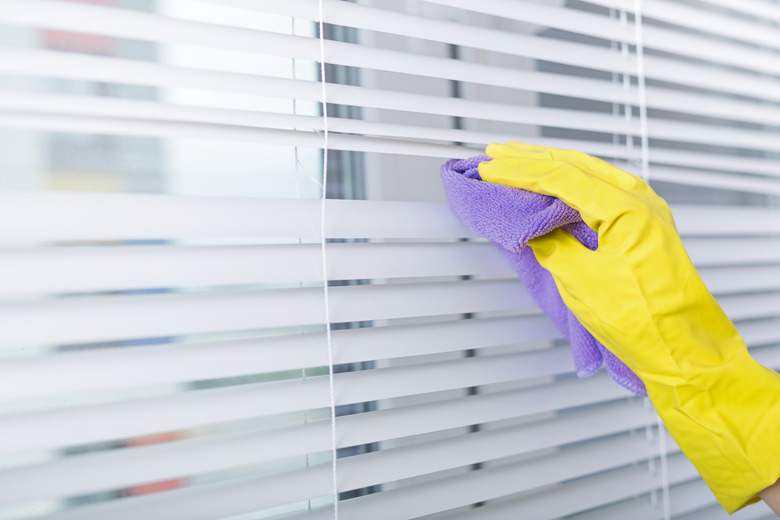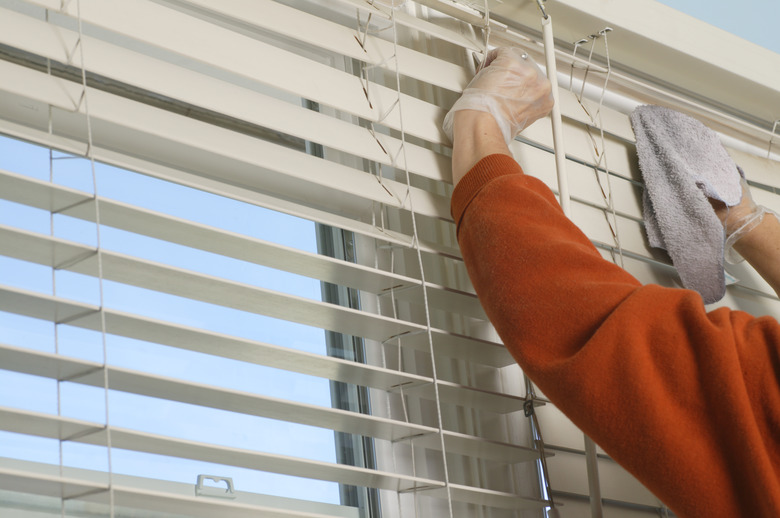How To Clean Your Blinds With Things You Already Have At Home
We may receive a commission on purchases made from links.
Be honest: When was the last time you even thought about cleaning your blinds? Like just about any other window covering, blinds tend to attract a lot of dust and dirt — so much so that you may not even realize how dirty they are until you actually clean them.
The best way to clean blinds depends, of course, on the material from which they're made, but no matter the material, the first step is to remove as much dust as possible without using any moisture. Once you've removed the bulk of the dust, these additional cleaning methods (with things you already have at home!) can help bring those window blinds back to looking their best.
First, Dust Them Thoroughly
First, Dust Them Thoroughly
When you have blinds in the house, dealing with dust is just a fact. Though you might be tempted to swipe a damp microfiber cloth to eliminate all the buildup, this is actually a bad and ineffective idea. Using moisture when they're really dirty could just spread the dust around, making them look even worse.
For an effective dusting, begin with a device that's appropriate for blinds. For nonporous blinds, such as those made of metal, vinyl, or wooden blinds, wipe them down with a microfiber mitt or a lint-free cloth (i.e. a dry one). Close the blinds so the lowest edge of each slat faces you and then start wiping across each slat, beginning with the top row. Once you've removed as much dust as possible, open the blinds and close them the other way so the top edge of each slat faces you in the room. Afterward, open the blinds and use the cloth or mitt to wipe any remaining dust you notice, such as around the cords that pass through on each side.
For fabric blinds or for any remaining dust not picked up by your microfiber mitt, a vacuum cleaner with a brush attachment works well. Once again, close the blinds, clean from the top row down, and then reverse the blinds and clean the other side. Be sure to wipe off the window frame and windowsill with a dry cloth as well since these areas also accumulate plenty of dust.
Clean Blinds With Damp Cloths
Clean Blinds With Damp Cloths
For your sturdier blinds (plastic, vinyl, or metal), a little soap water on a damp sponge or cloth can help clean any remaining buildup that the initial dusting didn't get. Avoid using water on real wood blinds, however, as it could cause them to warp.
Here's how to clean window blinds with damp cloths effectively:
- To get started, fill a bucket partway with warm, soapy water and then dip your sponge or lint-free white cleaning cloth into it, wringing out most of the moisture.
- Wipe down each slat with your cloth or sponge. If the blinds flex as you wipe them, brace them from underneath with your free hand. Wrapping the damp cloth around a fingertip can also help you wipe around the cords that go through each blind.
- Keep a separate bucket of clean water as the rinse bucket for your sponge; otherwise, the soapy water may get dirty while you're cleaning.
- If you've wiped the blinds in their fully open position, flip the blinds closed so the previous bottom side faces inward and then wipe them down again.
Clean Vertical Blinds with an Upholstery Brush
Clean Vertical Blinds with an Upholstery Brush
Though cleaning vertical blinds is similar to traditional horizontal ones, there are a few key differences:
- Start by dusting vertical blinds with an upholstery brush attachment on a vacuum cleaner, working your way from the top and move down with the blinds partway open. This will allow enough room to put your free hand behind each strip for added support. Once you've completed one side, be sure to vacuum the reverse side of each blind as well.
- If the upholstery brush attachment isn't working, try a natural-bristle paintbrush. To use this method, work from top to bottom with the tool, placing rags beneath the blinds to help catch any dust and debris that falls as you work.
- If your vertical blinds have a lot of buildup, try washing sturdy, nonfabric vertical blinds using a bucket of warm, soapy water and two sponges or sponge cleaning mitts. Set a series of old towels beneath the blinds to catch drips, and then dip the sponges into the soapy water, wring out excess moisture, and wipe down both sides of the blind at once — one side with each hand. Follow up with a bucket of fresh water. Once they are thoroughly rinsed, dry each slat on the clean blinds using a fresh lint-free cloth, drying both sides at once.
Clean Miniblinds with a Microfiber Tool
Clean Miniblinds with a Microfiber Tool
The slats on miniblinds are a bit small, making them more awkward to clean. The easiest way to give them a thorough cleaning is with a microfiber blind-cleaning tool. This device features soft, lint-free pads that slide between the slats when the blinds are fully open and horizontal. Look for a blind-cleaning tool that has removable, washable microfiber covers for maximum usefulness. Many of these tools also work well on blinds with larger slats. Here's how to use this tool effectively:
- To clean, open the miniblinds so the slats are horizontal and then push the tool over the slats so the microfiber pads span them.
- Wipe across the blinds until you've cleaned each slat.
- If the blinds are extra dusty, vacuum the microfiber pads on the cleaning tool from time to time to catch any major debris.
Spot Clean Blinds with a Cloth or Magic Eraser
Spot Clean Blinds with a Cloth or Magic Eraser
In areas like the kitchen, blinds may end up with spots of extra grunge, requiring more than a mere dusting. Since a good spot-cleaning usually involves moisture, read the manual that came with your particular blinds (or look it up online) to determine the best way to deal with random grimy areas, as moisture or scrubbing may harm some blinds, especially those of the fabric variety.
Ready to spot clean? Here's how to do it effectively:
- Place a little soapy water on a lint-free cloth or scrub sponge, squeezing out the excess water.
- Gently wipe the affected area with the cloth or sponge.
- Follow up with clean water on the cloth, wringing out most of the liquid once again.
- A melamine foam eraser (or a Magic Eraser) also works well on some types of grime. Wet a corner of the melamine foam, squeeze out excess moisture, and rub the damp area over the dirty portion of the blind. If you're concerned about whether the foam eraser may damage the blinds, test it first in an inconspicuous area, such as the back side of the blinds in a bottom corner.
Deep Clean Washable Blinds in the Tub
Deep Clean Washable Blinds in the Tub
Miniblinds and some other blinds made of plastic, vinyl, or metal may need an occasional soak in soapy water to remove clinging dust and debris, but the soak method should never be used on wood, fabric, or other materials that might be damaged by so much moisture.
- Remove as much dust as possible first, and then fill the bathtub with several inches of warm water and enough liquid dish soap to make the water a little foamy. A grease-cutting soap is a great option for grime that just doesn't seem to come off the blinds with other methods.
- Remove the blinds from the window while they're fully extended to cover the window but with the slats in the open position. In most cases, small panels slide out of the corners of the upper blind housing, allowing the blinds to be easily removed, but if you can't figure it out, consult the owner's manual, as models and brands vary.
- Move the blinds carefully into the bathtub.
- Wipe each slat thoroughly with a sponge.
- Drain the bath water and fill the tub with enough clean water to soak the blinds again. If your shower has a removable wand, use that to rinse the blinds.
- Drain any remaining water in the tub and either set the blinds on a series of towels to dry or find a way to hang them so they'll drip into the tub. You may be able to hang them from your showerhead or from other protrusions in the tub area.
- Once the blinds are completely dry, hang them where they belong.
References
- FactoryDirectBlinds: The Best Way to Clean Blinds Without Taking Them Down
- Architectural Digest: How to Clean Blinds Quickly and Easily With Supplies You Already Have on Hand
- Filtrete: How to Deep Clean Different Types of Blinds
- Merry Maids: Window and Blinds Cleaning
- Blinds.com: How to Clean Vertical Blinds


